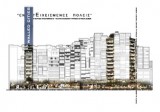Supervisor:
2011
In my Thesis I ’ve continued working on the concept that was posed and developed in my research project, entitled “Wells as spatial metaphors of the self (ego) in literature”. This project referred to, commented on, and correlated literature texts involving a particular kind of space : frear (the well in ancient greek) and then was attempted a parallelism of this space with the ego and the most basic part of it, the memory.
On this project the concept of the “frear” was used as an analog of the vertical interstitial empty spaces between high-rise buildings in big modern cities, a kind of “urban well”, an empty space that disrupts the continuity of the front of the city. In order to use the contrast of the empty well with the solid ground (it’s very obvious on the cross section) as a tool in rereading the cities, I ’ve chosen to work with cities of the highest density globally, such as favellas in Rio de Janeiro and Mexico, Kowloon in Hong Kong and other slums. My study focused on the successive elevations of the buildings of slums, walls, city-fronts, external borderlines. I was especially interested in the contrasting spatial relations that develop on walled cities, such as of light and shadow, or empty and full, or niche and extrusion. Then diagrams and models were made to represent these relations. Moreover, social, political and financial factors were taken into consideration, data that created this kind of structures and buildings, spatial projections of these particular factors. The aspect of the highest importance was the urbanistic tendencies that led to these organic kind of structures.
The final product of this research is a manual, a diagram with lists of the notions that were researched. The diagram (like an array) has horizontal and vertical columns organized according to the main notional units. The horizontal categories are four: 1. the first kind of space that I worked with (well), 2. the space that was firstly parallelized with the well (Ego), 3-4. the buildings and the city, where this whole “well” concept could find its urban analog (the scale becomes bigger enough to approach the architectural reality of walled slums). These four horizontal columns are combined on this board to five vertical, that include the notions that were used as tools to analyze the horizontal ones. The vertical ones are : the infrastructure, the structural contrasting relation “empty – full” , the city-fronts, the social status, and finally the intervention strategies (referring only to buildings and cities).
The diagram that was designed has horizontal and vertical organization of all these notions, and acts as a field condition of multiple possible paths, which give different results according to the way of combining the parts. An example could be Α VI 3-5 – B III 1-3 – Δ ΙΙΙ 4 – Ε VI 1 a random choice is a net of nodes, links routes, free and coincidental or result of thinking and planning, they lead to proposals in order to improve the living conditions in the slums. If we see this whole project more freely, these routes could refer to any city under different circumstances.
This “system” is nothing but a proposal to the difficult problem of the slums, but it does not claim to be capable of dealing with this particular urban matter as a whole. On the contrary, it provides spotted, small scale interventions, which occur to “weak” spots, places where people suffer more, where small “breaths” are necessary and relieving. If someone wanted to face this fact as a whole, (as many dictatorships have already done) one solution could be the bulldozer. But every sensitive man would be opposed to such an act, which directly hurts other people. When squatters are forced to be transported into megablocks they are miserable and unhappy, as these structures are not designed according to their needs. So, small scale, “surgery operations” would help the light and the air get into the walled cities maintaining the continuity of the front of the city.
